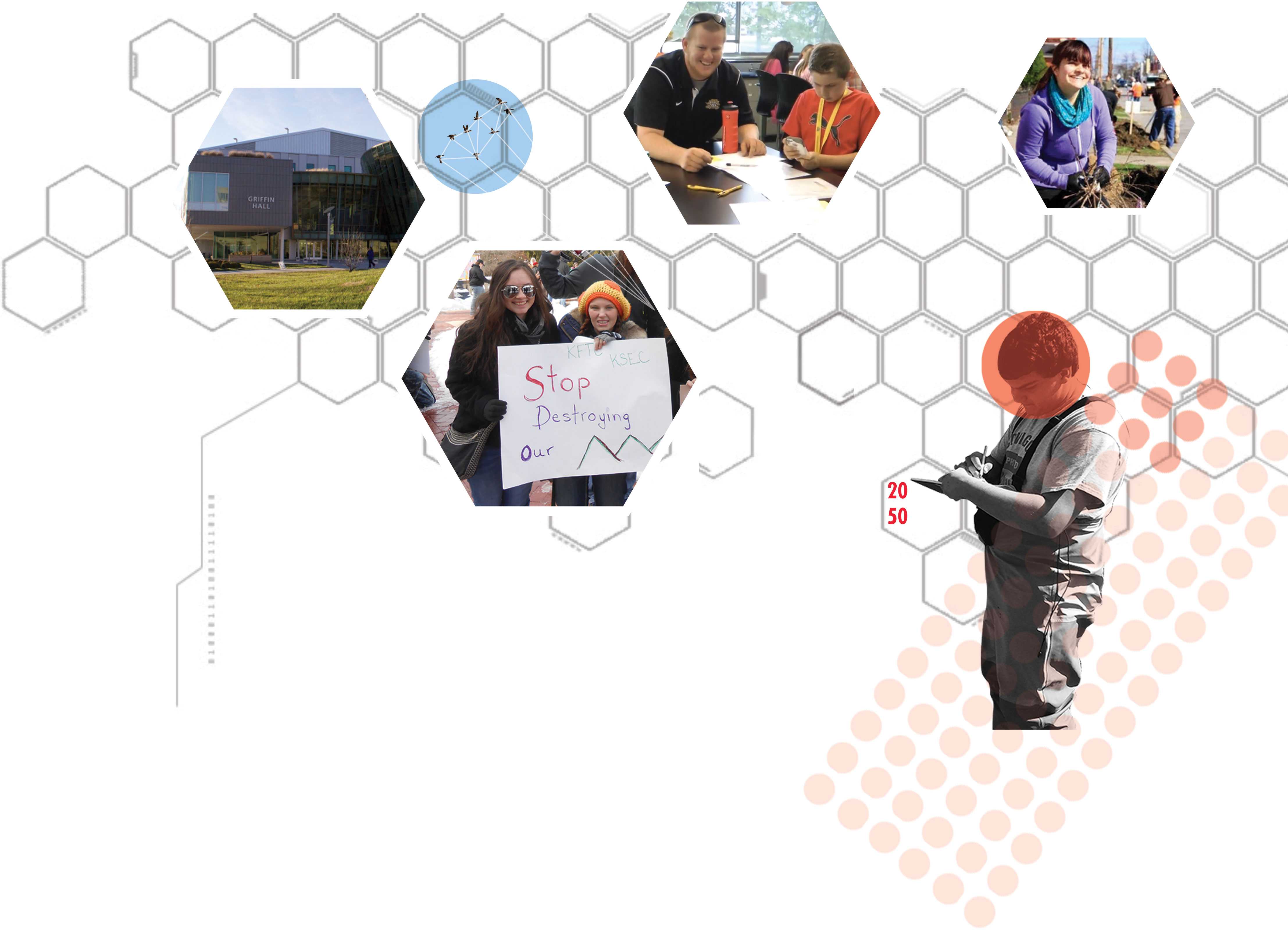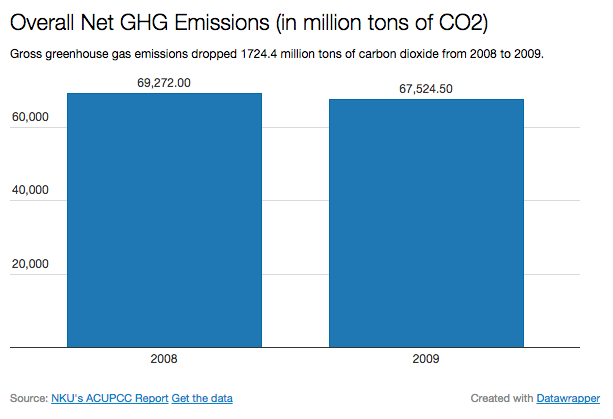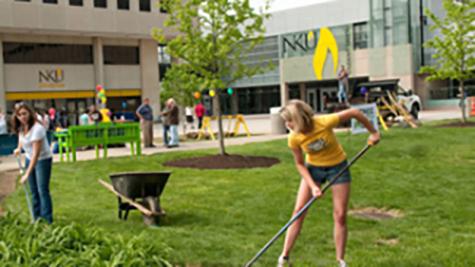University takes next steps in environmental evolution
December 28, 2014
Northern Kentucky University is in the midst of an environmental evolution.
The university is hiring a Director for Energy Management with plans to also hire a sustainability manager in order to have multiple designated full-time positions responsible for the planning, reporting and controlling of university energy and sustainability issues.
These new positions are the next step in a cluster of recent environmental initiatives within the university ranging from geothermal energy use in the campus recreation center renovation as a part of more sustainable construction practices, to pushing for further use of public transportation to reduce a large commuter carbon footprint, to developing water quality apps to help educate both the university and surrounding community.
The new positions will help to “work to further integrate environmental stewardship and sustainability into the campus culture,” NKU Director of University Planning Mary Paula Schuh said, referencing NKU’s mission as outlined in a former strategic plan.

The idea to have sustainability included in the university’s
new strategic plan actually came out of the prior strategic
plan–the Points of Focus Plan, according to Schuh.
Schuh played a part in the creation of that plan, which
spanned the time between former NKU President James
Votruba’s departure and current NKU President Geoffrey
Mearns’ installment to the university.
“It was to be a two year, 2012-2014, bridge plan. I actually
think I wrote the sentence,” Schuh said. “We didn’t feel
like people really cared. And that’s why we said ‘campus culture.’”
Schuh also played a part in creating NKU’s current strategic plan
where sustainability was therefore also included.
Sustainability and energy work was formerly handled by NKU campus planner Jane Goode, as a small part of her overall responsibilities within her staff position at the university.
“The people in these new positions will be able to accomplish more than Jane has been able to accomplish because… they will carry the title,” Schuh said. “You know, it is easier to accomplish something when you are in charge, but also just the fact that their is the office sends a message to the university that, ‘Hey, this is something important because we have invested in it.’”
NKU President Geoffrey Mearns said this position is important because it will help hold NKU accountable to the principles of the institution and the commitments it has previously made.
“By having a single person who is looking across the enterprise like this person will do, it ensures not just our commitment but it ensures greater executions toward those principles and towards those commitments we have made,” Mearns said.
The Director of Energy Management position is already in the hiring process. Candidates have already been brought to campus for interviews, according to Goode. The position is expected to be filled within the next two months, with that person expected to fill the sustainability manager position within the next few months after that.
And to many people across the university, the creation of these positions has come right in the nick of time.
The university’s current sustainability standing
The university is currently behind on parts of their commitments to American College and University Presidents Climate Commitment (ACUPCC).
Former NKU President James Votruba signed the ACUPCC in December of 2007, thereby pledging that NKU would work toward climate neutrality and a zero carbon footprint by 2050.
While NKU was the first of the eight public Kentucky senior four-year universities to sign the ACUPCC, the university has since fallen behind in their reporting.
The university hasn’t submitted its greenhouse gas emission report since 2009, although it is required to be submitted every other year.

The ACUPCC commitment states that universities are required to lay out several plans and continuously update several pieces of information:
✓ Within 2 months of the Implementation start date, signatories will complete their Implementation Profile by submitting information on the institutional structure for developing their climate action plans, designating the institutional liaison, and choosing the two tangible actions that will be implemented before the end of year 2.
✓ Within 1 year, signatories will submit the results of their first greenhouse gas emissions inventory.
✓ Within 2 years, signatories will submit their climate action plans.
X Within 3 years and at least every other year thereafter signatories are committed to updating their greenhouse gas emissions inventories.
✓ Within 4 years and at least every other year thereafter, signatories are committed to completing a report describing progress in implementing their climate action plans.
However, the university has met most of the other obligations and has been transparent in their efforts to remain in good standings with their commitment.
Goode currently plays a large role in submitting the reports to ACUPCC (as a part of her responsibility within NKU Green), but with there being no specific role strictly to deal with items such as this, there hasn’t always been enough time to ensure compliance with each and every detail of the commitment.
“As a member of the ACUPCC we are required to assess our footprint,” Goode said. “We are behind — we are always behind. I think we are at a good point though because we are in the process of hiring the new Director of Energy Management and sustainability manager.”
Changes in NKU’s greenhouse gas emissions over the two years they were tracked. Click each graph below to expand it.
President Mearns sees one aspect of the new roles as serving like compliance officers to the university’s pre-established sustainability commitments.
“I think it will enable us to ensure that there is coordination and focus in all projects,” Mearns said. “If you think about it like a compliance office, there are various people in the university that are responsible for compliance. There is a compliance officer in athletics; there is a compliance officer associated with grants and contracts.”
Now there will be a “compliance officer” figure for sustainability.
The university reiterated this point with its latest mandatory progress report it submitted to ACUPCC.

“Although the campus has made progress towards greater campus sustainability without a staff specifically tasked with the responsibility, NKU hopes to hire both an energy manager and a sustainability manager within the next year to increase the momentum toward its goal of carbon neutrality in 2050,” the progress report statement read.
President Mearns added that it is important we meet these commitments because he thinks it is NKU’s responsibility as an educational institution to lead in these areas.
“That’s what we are trying to do with a variety of the activities,” Mearns said. “Whether it is to make our campus more inclusive, to promote healthy choices and healthy lifestyles, or leading in the sense of ensuring we are good stewards of the environmental resources that we need and use on campus.”
But with all this taking place, figures across the university have applauded Goode for her help with the university’s sustainability efforts.
“She is very passionate about it,” Schuh said. “She has done a nice job with it, especially considering it being only a part of her job.”
As Goode celebrates six years in her current position at NKU this November, she will continue on in her current position as a campus planning coordinator — minus the responsibilities associated with NKU Green.
Many students and administrators, however, note that they still expect to see her at many sustainability events across campus, even if it’s not a job requirement.
They say Goode will always be the “green lady.”
Read more about Jane Goode’s unique voyage to NKU — from dancing in the big city to being the inspiration for environmental sustainability at NKU. And see how the “green lady” hasn’t always been green.
Click to read the story below.
Former modern dancer spins a web of ‘green’ influence at NKU:
From shaping space with her body to lines on paper and beyond
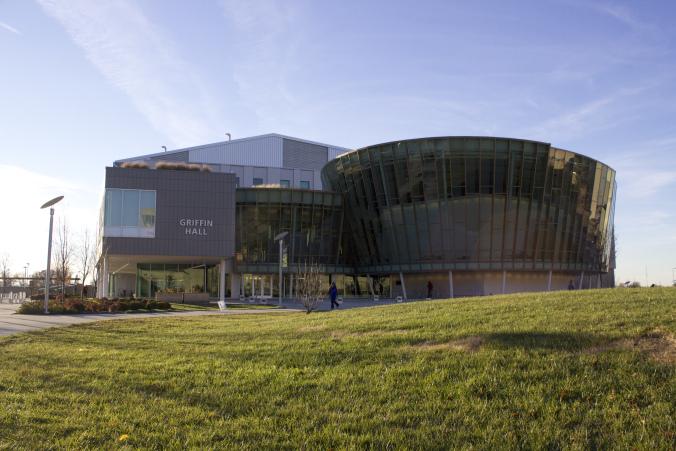
NKU raises its bar for sustainable construction standards
NKU is taking advantage of its recent and continued growth through implementing more environmentally sustainable construction and renovation practices in projects all across campus.
Though construction and renovation usually bring about negative effects on the environment, NKU is taking this opportunity to set a new bar for sustainable design and construction.
The university recently sent out a request soliciting bids for the forthcoming Health Innovations Center, which showcased a required minimum LEED Silver Certification in design for the new building.
LEED, or Leadership in Energy & Environmental Design, is a green building certification program that recognizes best-in-class building strategies and practices, according to U.S. Green Building Council.
To receive LEED certification, building projects satisfy prerequisites and earn points to achieve different levels of certification
What exactly do LEED Silver and Gold Certifications mean? And how do these certifications rank on the green building continuum?
LEED Certification can meet four different levels of distinction:

LEED Platinum Certification— 80 or greater credits
LEED Gold Certification— 60-79 credits
LEED Silver Certification— 50-59 credits
LEED Certification— 40-49 credits
The distinctions are ranked according to possible credit categories below:
1- Integrative Process
2- Location and Transportation
3- Materials and Resources
4- Water efficiency
5- Energy and atmosphere
6- Sustainable sites
7- Indoor environmental quality
8- Innovation
9- Regional Priority Credits
University President Geoffrey Mearns said this Silver Certification has become a minimum requirement for new construction across campus and that a LEED Gold Certification is being sought out for the new Health Innovations Center building as a new preferred, but not required, minimum for sustainable construction and design standards on campus.
He said the university hopes to have at least that same LEED Silver Certification bar met for any renovations or reconstructions that take place across campus in the coming years.
Recent construction and renovations projects are as follows:
2008
Callahan Hall — the 434-bed residence hall is created in a renovated retirement home, saving the costs and materials otherwise associated with a new construction
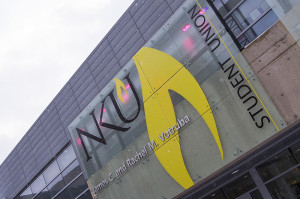
Student Union — the 150,000-square-foot building has low-energy mechanical and lighting systems, glass that cuts down on heat gain and concrete made with recycled fly ash. (This facility was built before the state government mandated that projects of over $25 million had to be designed to be LEED Silver.
Bank of Kentucky Center — the 243,000 square-foot multi-purpose event center, is a significant energy consumer
2011
Griffin Hall — the building achieved LEED Silver certification, and is NKU’s first LEED certified building.
2014

University Plaza — the renovated plaza reduced the square footage of impermeable surfaces in the center of campus, which includes a large green roof.
Norse Commons — the renovation to the campus dining facility was not designed to meet LEED certifications.
Northern Terrace — the newest residence hall lies within a former senior living center, saving the costs and materials otherwise associated with a new construction
Ongoing
Campus Recreation Center — the renovation of the campus recreation center, and upgrades to existing HVAC and other infrastructure as needed to achieve code compliance, LEED Silver certification (or gold) and to improve occupant comfort
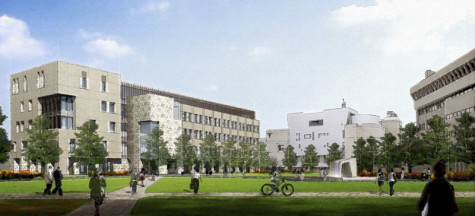
Planned
Health Innovations Center — the new construction will potentially be LEED Gold certified, or a minimum of LEED Silver certified, including a potential LEED certified renovation of the to-be connected Founders Hall.
Sustainable planning is key to a ‘greener,’ more responsible campus
While Mearns noted the university’s commitment to sustainability is even now a part of the university’s new strategic plan, others at the university have seen sustainability as a part of the campus planning process for decades.
“The interesting thing is that the university was always been interested in sustainability and it has always been our priority to design the buildings for energy efficiency and for the campus to operate efficiently,” Mary Paula Schuh, director of university planning, said.
Schuh has been at NKU for 35 years and has seen the university grow tremendously in that time.
Nunn Hall, Founders Hall and Regents Hall were the first three buildings, according to Schuh. The fourth buildings were the library and the power plant, simultaneously. She said people call it the power plant but that it really is a steam and chilled water plant. From then on all the academic buildings were connected to the steam and chilled water plant.
“That is a very efficient way to operate the campus,” Schuh said.
At this point, all of the academic buildings, including The Bank of Kentucky Center, operate with chilled water and steam from the central plant.
Various other aspects of the campus have also been considered for their efficiency in the distant past.
The first several buildings didn’t have double-paned windows, but that changed and then became standard, according to Schuh.
Perhaps, however, the most visible and prominent example of the university’s commitment is the new Health Innovations Center project, Mearns said.
“If we are able to get LEED Silver or LEED Gold with the entire renovation we will then have done something even more substantial which is taking an older building which did not meet those sustainability standards and meeting that higher standard as well and that’s a real challenge.”
While the construction initiatives the university is taking is pushing the university in the right direction, according to University Planner and NKU Green representative Jane Goode, the issue ultimately boils down to creating a culture of sustainability on campus.
“Since I have been here, I have a really always wanted to have the campus have a culture of sustainability,” Goode said. “You know, there are some people who are really conscious and some people who are unconscious. I would like to wake people up to be active participants for sustainability.”
Not that it causes them problems in getting through their lives, but it actually makes them more conscious of being alive and participating in the world. I think it is so easy to be oblivious and think that what you personally do is unimportant. But, I think living sustainability is important.”
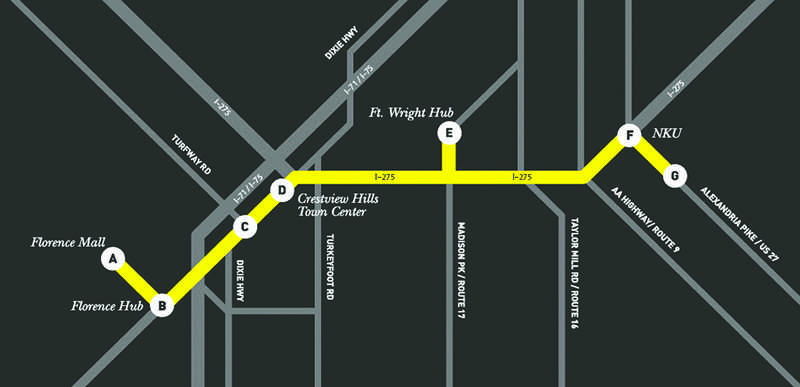
Tranportation issues could be university’s key concern
About 42 percent of NKU’s total carbon footprint, or the amount of carbon dioxide and other carbon compounds emitted due to the consumption of fossil fuels is from transportation, according to University Planner Jane Goode.
That’s a large amount compared to other universities, according to NKU President Geoffrey Mearns.
The primary cause? NKU’s current commuter culture.
“One of the disadvantages to being in a suburban location is that we are so convenient to car traffic,” Mearns said. “By being a campus with a significant number of commuters, it is going to affect your carbon footprint in a way that would be different than if you had 80-90 percent [of students] living on campus.”
But there are ways that NKU can combat those figures to help reduce its carbon footprint.
Mearns and Goode alike see one of the biggest ways to do so as taking advantage of TANK.
TANK
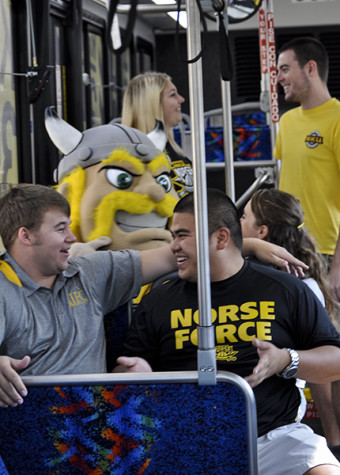
Victor E. Viking and NKU students taking route 35x.
Mearns met with Andrew Aiello, the executive director of TANK, a month ago to speak about this issue.
“I would very much like to have more public transportation options on our campus,” Mearns said.
Currently NKU students get to ride TANK for free using their all cards through a program called U-Pass.
TANK also operates the shuttle between Callahan and the main campus.
And figures for TANK use by NKU students do seem to be on the rise.
“September was a fabulous month and the numbers were really high for people using TANK,” Goode said. “They were even higher than usual.”
Recent initiatives such as instating an east-to-west TANK route (the 35X) could be a reason, according to Goode.
Although both she and Mearns both hope the number of NKU students, faculty and staff who take advantage of TANK only continues to rise.
“I am kind of hoping with the 35X that students would at least consider it,” Goode said. “If people would do that, that would be big, really big.”
Car share
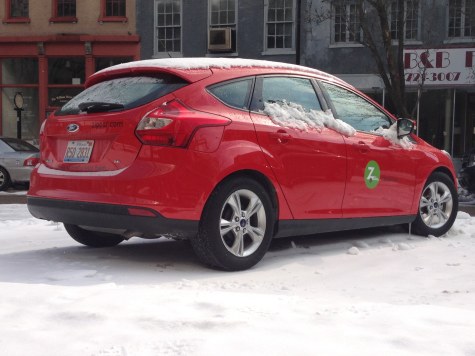
Car sharing, or “ridesharing,” is one option to help reduce the university’ carbon footprint (due to transportation) that has been looked at several times in the university’s past.
NKU Student Government Association President John Jose worked on this issue in one of his very first projects as freshman senator.
“We did a lot of research,” he said, “but I don’t think NKU was ready for it yet. There was a liability issue.”
The liability issue Jose mentioned with the car share program could cost the university a lot of money, but that it could be something that the university continues to look toward in the future.
Jose worked with other senators and Goode on creating this rideshare resolution for SGA.
Goode said she would still like to see some sort of rideshare initiative in the works for NKU.
“I still would like to see a rideshare program, but that would definitely cost the university something,” Goode said. “Regardless, I have been seeing more people in cars on campus. People seem to be more willing to modify their schedules to ride together, which I think is fabulous.”
One thing Goode thinks could help as a more limited version of car sharing is having a couple of Zipcars, which are cars placed in a location that may be rented by the hour or day, on campus.
If people who take TANK or would take TANK had an emergency they could use those, Goode said, which could help increase the number of TANK users if nothing else.
Bike Culture
Jose said one other solution to the transportation issue could be the promotion of a more bike-friendly campus.
“We [SGA] are working on getting a lot more bike racks and even maybe covered bike racks on campus,” he said.
Jose hopes those efforts will help establish and promote a culture on campus where bike riding is a convenient option, therefore cutting back on the amount of students usign their car to get from close-by apartments or dorms.
Mearns said he would be interested in hearing about ways to promote a more bike friendly culture on campus, but questioned the impact it could have based on the distance that many students, faculty, and staff all travel in order to get to NKU.
Goode believes a bike culture would be something easy to create on campus.
“I would hope the sustainability manager would get that done. Because I think it would be great, not only for our carbon footprint, but for peoples’ wellness as well.”
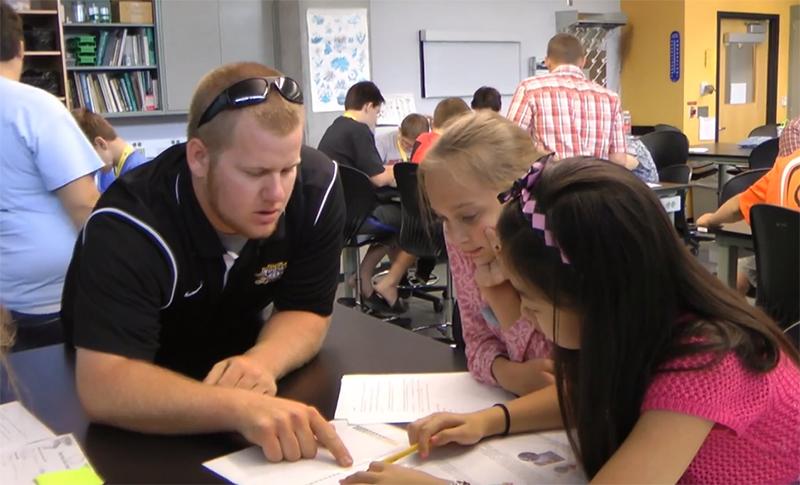
Center spreads environmental education throughout the university and beyond
Clay Tyler is no environmental expert.
As a senior middle grades education major, he sits in class (almost) everyday like most NKU students and doesn’t spend time thinking twice about the impacts of his drive to campus or the bottled water he crinkles in his hands.
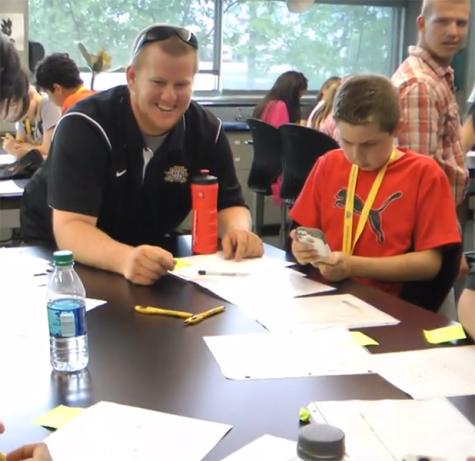
That, however, all changed this past year — in a way that has opened his eyes to the natural world around him.
Tyler took up a crash-course lesson in the world of environmental science after being hired at NKU’s Center for Environmental Education— working on educational outreach initiatives focused on environmental issues.
“It has definitely opened my eyes,” Tyler said. “I didn’t have a huge background in environmental science, but it will be helpful and important for my future down the road.”
Tyler heard about the position at the center, an institute within the Center for Integrated Natural Sciences and Mathematics aimed to improve regional environmental literacy, from a professor who suggested he apply for the job.
He heard it was funded by NASA and thought it had to be a great opportunity with such prestigious backing.
Now, as a student worker Tyler writes up lesson plans to be taught at schools across the country to help supplement the students’ learning and understanding of the environment around them — coupled with the science they are already learning or serving as extra lessons.
Within nine months Tyler went from not thinking about the environment at all to becoming conscious of it in many aspects of his daily life.
“I know way more now than I ever thought I would,” Tyler said. For example, “there is a water crisis around the world and we here Americans take it for granted. We think it’s not a big deal, you can just get a bottle of water and everything will be okay.”
Besides giving him new environmental insights, the position has also given him experience he can use within his profession after graduation.
Real-world experience has far-reaching influence
Tyler already writes lesson plans and practices teaching in real-world classrooms for his middle grades education major. However, his work at the center gives him even more of that real-world experience.
When not perfecting the center’s specialized lessons, Tyler gets to take students out in the field to local streams to implement the coursework he has created, along with the other student workers.
But not all student workers are education majors. All of the students workers come from different backgrounds, according to the center’s Interim Director and NKU Alumna Rose Marie Santos.
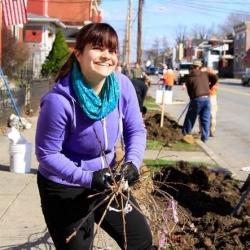
And that means the role offers a diverse wealth of experience to a diverse group of students.
“I have seen the center have such a positive impact on the students who work for it,” Santos said. “I’m a perfect example of one of those students. It’s been amazing for me coming from the student side to watch it happen for my students. It’s really just kind of a powerful thing.”
The center for environmental education was established by the Kentucky Environmental Education Council. They developed a state mandate requiring all state, public universities to have centers for environmental education in the ‘90s.
From that mandate, the universities formed the Kentucky Universities Partnership for Environmental Education (KUPEE). KUPEE currently has six active centers, NKU, Moorehead, EKU, Western, Murray and KSU. All of those centers are currently in different stages at this point, but some of them are actually funded by their institute.
The lesson plan project funded by NASA is one that all of the universities are a part of.
Each of the university’s centers has a group of students developing lesson plans. They are all thematically different, but they are all connected to the environment.
Sustainability is one topic. Climate change is another. NKU’s is water quality.
“We have to be flexible depended upon what the funding is. If we apply for a forestry grant, we are going to do more forestry projects. If we are going to apply for a Duke Energy grant. we would focus more on energy.”
The center also got money to develop a water quality app. This was a project that was a partnership between the Foundation for Ohio River Education and NKU’s center.
“We had this amazing app that was a great resource for teachers and a lot of people were already using it, but for the lay teacher who has never taught water quality, well, what am I going to do with it? Well now there is a lesson plan to accompany it?” Santos said.
The lesson plans utilize the water app to help local teachers better teach their students.
“It starts out with the big picture: What is water quality? What is a watershed?” Santos said. “Then it goes into what chemical testings are, what biological testings are, and then the fourth day is an accumulative field trip and that is when they use the app in the field.”
So it’s a product essentially that the center is offering for teachers. The lesson plans are free. The water app is $4.99 on iTunes.
The overarching goal would be to push toward environmental education and create resources so that teachers have access to materials that can help them with that process.
Connecting back to nature, within NKU and beyond
Elementary and middle school students who are taught the lessons receive an additional insight, according to Santos. They regain a connection to the natural world.
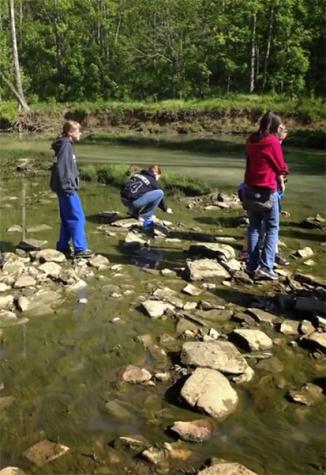
“It’s just so great because kids don’t get to do this anymore. If they learn anything awesome, that’s great, but just allowing them to get out into nature is great,” Santos said. “I’m from Cincinnati. I think back to what made me care about the environment. It was walking in streams and not really knowing what I was doing but just being outside after years of not being outside, it changed the way that I experienced nature.”
Several studies have shown that many kids nowadays aren’t being exposed to nature in the same ways that older generations were, according to Santos. That has an impact on the way they perceive their connection to it.
“They are really disconnected from where their food comes from, how when you flush the toilet it affects the water, their connection is far less clear. 100 percent I just think getting the kids outside is a victory in itself.”
Tyler agrees and said getting to take students out in the field to learn is his favorite part, as well as theirs.
“We took a group of sixth graders out to a stream and they did some collecting of macroinvertebrates and did some chemical testing of water to determine its quality or healthiness,” Tyler said. “The field study, when the students get to go out to the creek, is always their favorite part because you know they get to play around in the water.”
Santos said that this is one of the main things that inspired the app. If you put the app in the hands of kids who are a little more tentative to be outside, suddenly they become interested about how it all comes together.
“The best thing for me is they become less interested in the app and more interested in the bugs.”
Ultimately, Santos believes this environmental education is important for all ranges of students involved, because it impacts one’s ability to be civically engaged and responsible.
“If people don’t have an understanding of science, they don’t understand, they can’t vote appropriately. There is so much false information, that even the most basic understanding of science can help a person rationalize through that,” Santos said. “That’s a major reason why I want to target an undergraduate audience with the CEE because I think it is 100 percent important. “

